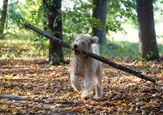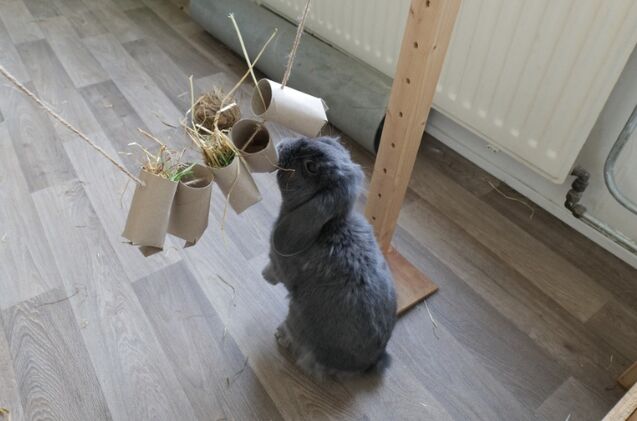Budget-Friendly DIY Rabbit Enrichment Ideas for Every Bunny Parent

As a dedicated rabbit parent, your commitment to providing the very best for your furry companion is undeniable. You want them to thrive, not just survive. That is where the world of mental enrichment comes in. But why is it that when you walk the aisles of your local pet store, all the enrichment toys and products seem to be made for dogs and cats?
The good news is that providing excellent enrichment doesn’t require special toys or a hefty budget. In fact, many of the most engaging toys and activities for your bunny can be created using items you have lying around your home.
In this post, I’ll explain why enrichment is so important for your rabbit’s overall well-being and share a list of fun, budget-friendly ideas that will have your bunny hopping with joy in no time!
When Enrichment Matters for Your Bunny
We often see trends or buzzwords pop up in the pet space, trying to convince us that something is important or necessary for our furry family members. But enrichment is more than that… It is truly a game-changer for your rabbit’s health and happiness. Here’s why:
Mimicking Natural Behaviors
In the wild, rabbits are high-energy creatures and are constantly on the move. They spend much of their time foraging for food, exploring their surroundings, digging intricate networks of burrows, and interacting with their environment. These aren’t just random activities; they are deeply ingrained instincts.
Domestication, while providing these sweet pets with a safe and comfortable home, often limits these outlets. Confined to enclosures, even spacious ones, our pet rabbits can miss out on the mental and physical stimulation they would enjoy from these natural behaviors. By recognizing this, we can find ways to replicate these opportunities and provide safe outlets to fulfill these instinctual needs within the safety of their own home (your home).
Combating Boredom and Stress
Like us, our rabbits can experience boredom when they aren’t given sufficient stimulation. This lack of mental engagement can lead to a variety of negative behaviors and signs of stress.
Signs of bunny boredom include:
- Excessive grooming, sometimes to the point of creating bald patches
- Lethargy
- Lack of interest in their surroundings
- Sitting hunched in a ball
- Persistent chewing on cage bars or inappropriate household items
- Digging in their enclosure or bedding
- Repetitive, seemingly aimless pacing or restlessness
- Out-of-character escape attempts
- Making a grunting noise
- Aggressive behaviors, including nipping or biting
Enrichment provides crucial mental stimulation, offering them entertainment, puzzles to solve, new scents and textures to explore, and challenges to overcome. This reduces their boredom and promotes a calmer, more content mindset.
Promoting Better Physical Health
We often discuss the mental health implications of enrichment, but it also plays a vital role in promoting physical health. Encouraging movement and activity helps prevent the development of obesity, a common and growing serious health concern in domestic rabbits (and, quite honestly, nearly all pets in the US).
Regular activity can be encouraged by providing enrichment opportunities, like exploring tunnels, hopping over obstacles, and reaching for hanging treats, all of which help keep their muscles strong and their cardiovascular system healthy.
Some enrichment items contribute to your rabbit’s dental. A rabbit’s teeth continuously grow. In the wild, they wear down their teeth by chewing on grasses, hay, and other abrasive surfaces, but not all food provided to domesticated rabbits will fill this need. You can provide your bunny with safe and appropriate items to chew on, such as untreated wood or cardboard, to meet this need and prevent painful dental issues.
Strengthening the Human-Animal Bond
Engaging in enrichment activities with your rabbit is a great way to spend quality time together and strengthen that all-too-special human-animal bond. When you take the time to create a new puzzle toy, design a foraging box, or simply observe and interact with your rabbit as they explore their enrichment environment, you’re building trust and deepening your connection.
Watching their curiosity and problem-solving skills in action is not only rewarding for you but also creates positive associations with your presence. These shared moments of play and discovery are a great way to boost your relationship and build the long-lasting bond we all want to enjoy with our furry family members.
DIY Enrichment Ideas: Foraging Fun
Foraging is a deeply ingrained natural behavior for rabbits, extending beyond simply searching for their food. In the wild, rabbits will spend much of their day searching for, selecting, and acquiring their meals. This process is highly stimulating, engaging many senses, including smell, sight, and touch. It also helps to keep their minds actively engaged.
By providing opportunities for foraging in their home environment, we can tap into these instincts and give our bunnies crucial mental enrichment. Here are a few ways to create foraging opportunities at home:
Treat Balls/Rollers
Turn simple cardboard tubes, such as those from toilet paper or paper towels, into engaging treat dispensers. Cut a few small holes in the tube and place hay or small, healthy treats inside. When given to your bunny, they will need to nudge, roll, and manipulate the tube to release the tasty rewards.
Of course, you should always prioritize safety. If you are using glue, do so sparingly, or simply fold the ends of the tubes to securely keep the goodies contained.
Hay Boxes/Digging Boxes
Repurpose larger cardboard boxes to create stimulating digging and burrowing opportunities. Fill these boxes with rabbit-friendly textures like loose hay, shredded plain paper, or safe, untreated soil. This provides both physical activity and a chance to tap into their natural sense of curiosity and exploration. Different textures also offer a more satisfying tactile experience.
Cardboard Castles/Tunnels
Encourage exploration and discovery by creating simple structures from larger cardboard boxes. By cutting openings and connecting boxes, you can build tunnels, hiding spots, and multi-room “castles” that offer a change of scenery and opportunities for your rabbit to hop through, hide, and feel secure.
Is your rabbit hesitant to explore their new fort? Consider using small treats to create a trail guiding them through the space. Once they have checked out and seen every corner, they will be far more likely to embrace their new castle.
Hay-Stuffed Paper Bags
You can create a simple yet engaging foraging opportunity by stuffing plain, unprinted brown paper bags with fresh hay and a sprinkle of safe, rabbit-friendly herbs. While timothy hay is the most commonly recommended hay option for rabbits, you can mix in some orchard grass, meadow hay, or oat hay for a little variety. This allows your bunny to shred, toss, and forage through the tasty contents.
Hanging Hay Racks
Create simple hanging hay racks using sturdy cardboard or even repurposed, clean plastic containers. When attaching these racks to your rabbit’s enclosure, be sure that you are using secure, rabbit-safe attachments. By spending the hay slightly off the ground, you are not only keeping it clean and fresh, but you’re also encouraging them to stretch and reach for their food, adding a physical element to their mealtime routine.
Scattered Mealtime Fun
You can create a natural foraging environment indoors by scattering small amounts of safe, rabbit-friendly herbs and leafy greens around their enclosure. This encourages them to actively search for and sniff out their treats, engaging their natural instincts and providing mental stimulation.
Willow and Apple Branches
Do you live in an area with willow or apple trees growing? This is a great way to incorporate a natural element into their environment with interesting textures and scents to explore. They also provide a safe outlet for chewing, which (as we already discussed) is essential for maintaining their dental health. But be sure that any natural materials you are sourcing outdoors are from areas free of pesticides or other harmful chemicals.
DIY Enrichment Ideas: Puzzle Power
Puzzle toys are a great way to engage your rabbit’s mind, keeping it sharp while encouraging their natural problem-solving abilities. The following DIY toys present a challenge that your bunny needs to figure out to access their reward.
Muffin Tins with Balls
A simple yet effective food puzzle can made with nothing but a muffin tin and some lightweight, rabbit-safe balls or even crumpled balls of paper. Place small treats or your rabbit's food pellets in the cups of the muffin tin. Then, cover some of these cups with balls or crumpled paper. Your bunny must use their nose and paws to move the obstacles and uncover their snacks.
Plastic Bottle with Holes
Clean and thoroughly dry a plastic bottle, such as a pop or water bottle. Ensure there are no small, detachable parts that could be ingested. Cut several holes into the sides of the bottle that are large enough for small treats to fall out. Place a few treats inside and seal it up. Your rabbit now has to manipulate the bottle (nosing it, rolling it, and moving it around) to release the tasty surprises.
Always supervise your rabbit when first introducing this puzzle. While some will understand the concept quickly, others may try to chew their way through to the treats, ingesting the plastic.
Stacking Cups/Bowls
You can use stacking cups or bowls to create a simple hiding game. Place treats under one or more of your cups and then stack or arrange them in a way that requires your rabbit to investigate and move them around to find the hidden treasures. This encourages both exploration and memory.
Cardboard Box Mazes
Create a basic maze within a large cardboard box by using additional pieces of cardboard as dividers. Secure the dividers in place with rabbit-safe tape or by slotting them together. You can make your maze as simple or challenging as you desire but don’t jump to a complex maze too quickly, or you’ll discourage your rabbit from engaging in the fun.
When you’re done building, place a treat with an enticing scent at the end, and then release your rabbit in the maze to explore and find it. Gradually increase the complexity of the maze as your bunny gets the hang of it.
The Importance of Sensory Enrichment and Variety
In the wild, a rabbit’s world is rich with sensory information, including different textures to feel, sounds to hear, and smells to investigate. When living in a limited space for a long time, they can become bored because there is nothing “new” to keep their environment interesting. Introducing new sensory stimuli can help keep your rabbit engaged, prevent boredom, and improve their overall well-being. Here are a few sensory opportunities to consider:
Textural Enrichment
Consider offering areas with different flooring surfaces within their enclosure. This could include a soft, chew-safe rug, a cool ceramic tile, or a natural woven mat. Offering safe, untreated fabric scraps is another way to provide a new textural experience. Rabbits often enjoy digging, bunching, and rearranging soft materials. However, it’s crucial to supervise their interactions with fabric to ensure they are not eating it, as this could lead to serious health problems.
Visual and Auditory Enrichment
New sounds or smells can be added to your rabbit’s environment, but this should be done with caution and careful consideration of your rabbit’s personality and preferences. While some rabbits are comfortable in new settings, others may find these new experiences to be frightening, causing stress and anxiety.
Calming sounds, such as soft, gentle music played at a low volume, may be comforting for some rabbits, creating a more soothing atmosphere. But avoid any noises that are too loud or sudden.
Providing safe views, such as access to a window, can be stimulating. But pay careful attention to what may lie on the other side of the glass. Exposing your rabbit to the sight of birds of prey or neighborhood cats can be scary, even if these predators can’t actually get inside to harm them.
Comfort and Security
Providing your rabbit with multiple safe hideaways can contribute significantly to their sense of safety and enrichment. These can be simple cardboard boxes with entry and exit holes, tunnels, or other secure structures where they can retreat if they feel scared or overwhelmed. They may also use these spaces simply to enjoy some quiet alone time.
Ensure your bunny always has access to comfortable and safe bedding, like soft hay piles, fleece blankets (under supervision to prevent ingestion), or other rabbit-safe bedding materials. These spaces allow them to rest and feel secure while allowing them to burrow for further comfort.
Boost Your Rabbit’s Happiness with DIY Enrichment
Providing enrichment for your rabbit, especially through budget-friendly DIY options, offers many great benefits. It combats boredom, reduces stress, encourages natural behaviors, promotes physical health, and strengthens the bond you share with your furry friend. Ultimately, this leads to a happier and more fulfilling life for them.
I encourage you to get creative and have fun exploring the many possibilities for creating your own homemade enrichment using simple, readily available materials.
Remember, even small additions can make a big difference in your bunny’s world. By embracing a little ingenuity and creativity while understanding your rabbit’s unique personality, you can give them the happy, healthy life they deserve!
Join the PetGuide community. Get the latest pet news and product recommendations by subscribing to our newsletter here.

Britt Kascjak is a proud pet mom, sharing her heart (and her home) with her “pack” which includes her husband John, their 2 dogs – Lucifer and Willow – and their 3 cats – Pippen, Jinx, and Theia. She has been active in the animal rescue community for over 15 years, volunteering, fostering and advocating for organizations across Canada and the US. In her free time, she enjoys traveling around the country camping, hiking, and canoeing with her pets.
More by Britt
























